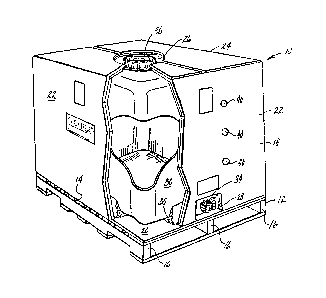Some of the information on this Web page has been provided by external sources. The Government of Canada is not responsible for the accuracy, reliability or currency of the information supplied by external sources. Users wishing to rely upon this information should consult directly with the source of the information. Content provided by external sources is not subject to official languages, privacy and accessibility requirements.
Any discrepancies in the text and image of the Claims and Abstract are due to differing posting times. Text of the Claims and Abstract are posted:
| (12) Patent: | (11) CA 1306704 |
|---|---|
| (21) Application Number: | 1306704 |
| (54) English Title: | COMPOSITE SHIPPING CONTAINER |
| (54) French Title: | CONTENANT D'EXPEDITION COMPOSITE |
| Status: | Expired and beyond the Period of Reversal |
| (51) International Patent Classification (IPC): |
|
|---|---|
| (72) Inventors : |
|
| (73) Owners : |
|
| (71) Applicants : |
|
| (74) Agent: | MACRAE & CO. |
| (74) Associate agent: | |
| (45) Issued: | 1992-08-25 |
| (22) Filed Date: | 1988-03-14 |
| Availability of licence: | N/A |
| Dedicated to the Public: | N/A |
| (25) Language of filing: | English |
| Patent Cooperation Treaty (PCT): | No |
|---|
| (30) Application Priority Data: | ||||||
|---|---|---|---|---|---|---|
|
ABSTRACT OF THE DISCLOSURE
A composite disposable one-way container comprising an outer
container of rectangular shape having upright continuous side walls and a
substantially flat top wall formed of corrugated paper material. A
unitary blow molded plastic inner tank having thin side walls is
positioned upright inside the outer container so that the outer container
maintains the inner tank in its upright position when the tank is filled
with a liquid to be transported. A pallet member has a flat top
supporting surface on which the outer container and the inner tank are
supported.
Note: Claims are shown in the official language in which they were submitted.
Note: Descriptions are shown in the official language in which they were submitted.

2024-08-01:As part of the Next Generation Patents (NGP) transition, the Canadian Patents Database (CPD) now contains a more detailed Event History, which replicates the Event Log of our new back-office solution.
Please note that "Inactive:" events refers to events no longer in use in our new back-office solution.
For a clearer understanding of the status of the application/patent presented on this page, the site Disclaimer , as well as the definitions for Patent , Event History , Maintenance Fee and Payment History should be consulted.
| Description | Date |
|---|---|
| Time Limit for Reversal Expired | 2003-08-25 |
| Letter Sent | 2002-08-26 |
| Inactive: Late MF processed | 2001-08-31 |
| Inactive: Late MF processed | 1999-09-02 |
| Inactive: Late MF processed | 1998-09-16 |
| Letter Sent | 1998-08-25 |
| Grant by Issuance | 1992-08-25 |
There is no abandonment history.
| Fee Type | Anniversary Year | Due Date | Paid Date |
|---|---|---|---|
| MF (category 1, 5th anniv.) - standard | 1997-08-25 | 1997-08-06 | |
| Reversal of deemed expiry | 2001-08-27 | 1998-09-16 | |
| MF (category 1, 6th anniv.) - standard | 1998-08-25 | 1998-09-16 | |
| MF (category 1, 7th anniv.) - standard | 1999-08-25 | 1999-09-02 | |
| Reversal of deemed expiry | 2001-08-27 | 1999-09-02 | |
| MF (category 1, 8th anniv.) - standard | 2000-08-25 | 2000-08-02 | |
| Reversal of deemed expiry | 2001-08-27 | 2001-08-31 | |
| MF (category 1, 9th anniv.) - standard | 2001-08-27 | 2001-08-31 |
Note: Records showing the ownership history in alphabetical order.
| Current Owners on Record |
|---|
| HOOVER GROUP, INC. |
| Past Owners on Record |
|---|
| JOHN, JR. VOORHIES |